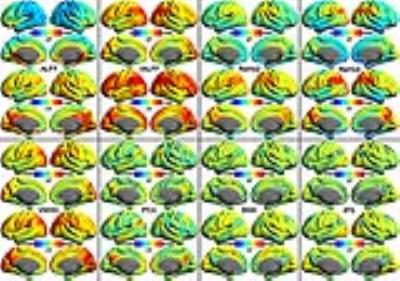5212
Test-Retest Evaluation Spontaneous FMRI Signal: HCP 7T Reliability1Chinese Academy of Sciences, Beijing, People's Republic of China, 2Beijing University of Technology, Beijing, People's Republic of China
Synopsis
We employed the test-retest HCP datasets scanned at both 3T and 7T scanners from a same group of 62 healthy adults to compare differences in common functional metrics of the human connectome between 3T and 7T rfMRI settings in terms of their regional variations, individual variability and test-retest reliability. Our findings revealed metric-specific differences in both spatial patterns and reliability between 3T and 7T scanners whereas 7T improves reliability of global metrics but reduces reliability of local metrics of the functional connectomes.
Introduction
The Human Connectome Project (HCP) shared multi-dimensional data of both brain and behavior collected from 1,200 healthy adults at a single site to the community. During development of the HCP, a set of standardized frameworks has been established for data collection, storage, analyses and sharing1. While HCP released resting-state fMRI (rfMRI) data for evaluation of a very short-term (two days) test-retest reliability, the Consortium for Reliability and Reproducibility (CoRR) offers data of various test-retest durations (from hours to years) across multiple imaging sites2. Both CoRR and HCP are increasingly becoming a testbed for standardized human brain connectomics. Previous findings revealed three major observations of test-retest reliability3,4: 1) metrics with closer structural or morphological basis are more reliable that those without; 2) local metrics are more reliable than global ones; and 3) advances of rfMRI (spatial-temporal resolution and scan duration) improve test-retest reliability. While all the previous reliability assessments in functional connectomics of the human brain were derived from 3T rfMRI data, no investigations exist to test reliability of functional connectomes derived from 7T rfMRI data although strength increases of the magnetic fields improved the signal-to-noise ratio5.
Methods
We employed the test-retest HCP datasets scanned at both 3T and 7T scanners from a same group of 62 healthy adults (age range: 22-35 yrs; mean age: 29.4 yr; 26 males) who had completed four rfMRI scans during two days at both 3T and 7T HCP scanners. Our analyses compared differences in common functional metrics of the human connectome between 3T and 7T rfMRI settings in terms of their regional variations, individual variability and test-retest reliability7. These common functional metrics include amplitudes6, local homogeneity4,7, homotopic8 and seed-based functional connectivity9 of the rfMRI signals. All cortical maps of these metrics were derived with the Connectome Computation System (CCS)10 based upon the HCP preprocessed datasets. Their test-retest reliability were measured by the intra-class correlation (ICC) with a set of linear mixed models.Results
It is pretty evident that the 7T magnet brings large improvements of the metric strength in term of their maps at group level (Figure 1). The maps also indicate a striking differences in regional variation of these functional metrics while this variation remains minimal for seed-based functional connectivity. Regarding test-retest reliability, Figure 2 clearly shows the improvements of global measures introduced by the 7T HCP sequence while reductions of local measures compared to the 3T HCP sequence.Discussion
Spontaneous signal measured with rfMRI during resting-state of the brain has been the primary data for modeling the entire functional interactions in the human connectome (i.e., functional connectome). While the previous functional connectome studies updated the level of our knowledge about how the brain works and generates behaviors as well as is altered by disease conditions, several challenges are emerging, among which achievement of the high-level reliability and reproducibility in functional connectomics represents the highest priority to various applications (e.g., development and diseases). A promising solution of building up the reliable and reproducible connectomics is developing standardized framework on connectome-based studies. Much like the human genomics field, the open science with sharing both codes and data is highly promising for a standardized connectomics. Our findings demonstrated that advances on imaging technology not only offer the reliability of various methods but also pointed out that these changes can be measure-specific to the functional connectomes. These outcomes provide references on the use of these measures for the HCP 7T datasets in future functional connectomics studies.Conclusion
Metric-specific differences in both spatial patterns and reliability between 3T and 7T scanners exist. The HCP 7T sequence improves test-retest reliability of global metrics but reduces the reliability of local metrics of the functional connectomes.Acknowledgements
Imaging data were provided by the HCP WU-Minn Consortium, which is funded by the 16 NIH institutes and centers that support the NIH Blueprint for Neuroscience Research 1U54MH091657 (PIs: David Van Essen and Kamil Ugurbil).References
1. Glasser MF, et al. 2016. The Human Connectome Project's neuroimaging approach. Nat Neurosci. 9(9):1175-87.
2. Zuo XN, et al., 2014. An open science resource for establishing reliability and reproducibility in functional connectomics. Sci Data. 1:140049.
3. Zuo XN, Xing XX. 2014. Test-retest reliabilities of resting-state FMRI measurements in human brain functional connectomics: a systems neuroscience perspective. Neurosci Biobehav Rev. 45:100-18.
4. Jiang L, Zuo XN. 2016. Regional Homogeneity: A Multimodal, Multiscale Neuroimaging Marker of the Human Connectome. Neuroscientist. 22(5):486-505.
5. De Martino F, et al. 2011. Whole brain high-resolution functional imaging at ultra high magnetic fields: an application to the analysis of resting state networks. Neuroimage. 57(3):1031-44.
6. Zuo XN, et al., 2010. The oscillating brain: complex and reliable. Neuroimage. 49(2):1432-45.
7. Zuo XN, et al., 2013. Toward reliable characterization of functional homogeneity in the human brain: preprocessing, scan duration, imaging resolution and computational space. Neuroimage. 65:374-86.
8. Zuo XN, et al. 2010. Growing together and growing apart: regional and sex differences in the lifespan developmental trajectories of functional homotopy. J Neurosci. 30(45):15034-43.
9. Biswal B, et al. 1995. Functional connectivity in the motor cortex of resting human brain using echo-planar MRI. Magn Reson Med. 34(4):537-41.
10. Xu T, et al. 2015. A Connectome Computation System for discovery science of brain. Sci Bull. 60(1):86-95.
Figures

